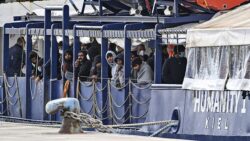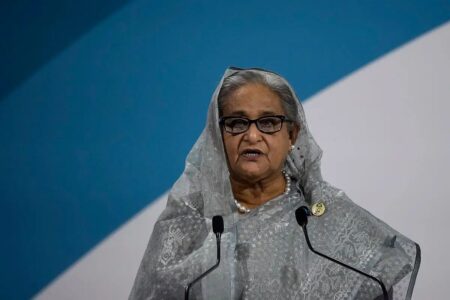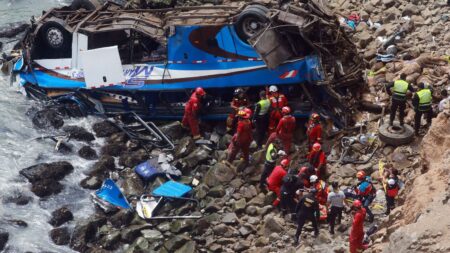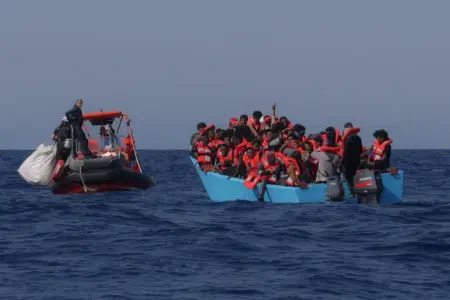After years immersed in a lethal pandemic, a historic recovery fund, a devastating war, an energy crisis and dizzying inflation numbers, EU leaders are ready to bring back migration to the very top of the political agenda.
The issue, responsible for opening deep fissures between EU countries, never actually faded away. But a 64% surge in irregular border crossings – around 330,000 – and a 46% rise in asylum applications – nearly 924,000 – last year have sparked a new sense of urgency among politicians to give the explosive topic another go.
Austria is calling for EU funds to finance a new fence along the Bulgaria-Turkey border. Italy is pushing for an EU-wide code of conduct for rescue ships in the Mediterranean. And Denmark, a country that pursues a “zero-asylum” policy, is seeking support to set up reception centres outside the bloc.
Brussels appears to have read the room: an extraordinary two-day summit has been convened this week to address migration and the control of external borders head-on.
The European Commission is trying to seize the moment to advance its long-stalled “New Pact on Migration and Asylum,” an intricate, holistic proposal that is meant to piece together all various aspects of migration policy and replace the existing ad-hoc crisis approach.
“Migration is a European challenge which must be met with a European response,” European Commission President Ursula von der Leyen wrote in a letter to leaders ahead of the February summit.
Crucially, the “New Pact” is based on the principle that has for years pitted member states against each other: fair sharing of responsibility and solidarity.
‘Between a rock and a hard place’
Under the so-called Dublin Regulation, adopted for the first time in 2013, the application submitted by an asylum seeker becomes the responsibility of the first member state of arrival.
This system has been widely criticised by governments and civil society organisations alike because it places a disproportionate burden on frontline nations, such as those in the Mediterranean, which are faced with the huge task of processing asylum claims from migrants who, quite often, do not want to stay in that country and prefer to travel north.
Here is where the big question at the core of the perennial debate emerges: How can the EU, as a political union with shared external borders, relocate and redistribute these hundreds of thousands of applicants in a matter that is considered fair and balanced?
So far, the answer has been: it just can’t.
“The current migration is caught between a rock and a hard place, essentially. Migration flows, migration pressures continue, but member states are finding it very difficult to agree on a set of effective and common solutions to that,” Andrew Geddes, the director of the Migration Policy Centre at the European University Institute (EUI), told Euronews.
“Some member states just refuse and will not participate in schemes that involve the relocation of migrants across the EU.”
‘A debate deprived of new energies’
The proposed “New Pact” offers another answer to the relocation dilemma: an “effective solidarity” mechanism.
The mechanism would present EU countries with three options to assist a fellow member state whose migration system is under pressure due to a surge in new arrivals: accept a number of relocated asylum-seekers, pay for the return of rejected applicants to their country of origin, or finance an array of “operational measures,” such as reception centres and means of transport.
The pledges would be calculated based on the country’s GDP and population. Once agreed, the European Commission would then adopt an act to make the pledges legally binding.
It doesn’t take too long to realise the system presents two conditions that are anathema to member states on opposing sides of the debate.
For those pushing for more relocation, such as Germany, France, Italy and Greece, the system lets reluctant countries off the hook by offering two options – return sponsorship and operational measures – that do not entail taking in any person inside their borders.
For those pushing against relocation, such as Poland, Hungary, Slovakia and Austria, the system introduces mandatory pledges that would force them to contribute whether they like it or not.
The clashing perspectives have condemned the “New Pact” to a legislative limbo, with little to no progress since its presentation back in September 2020.
‘National interests and short-term political agendas’
“There is no wonder drug or magic solution ready at hand to the divisive issue of responsibility-sharing,” Alberto-Horst Neidhardt, head of the migration programme at the European Policy Centre (EPC), told Euronews.
“For too long, the migration debate has been deprived of new energies and vital oxygen, pressed into a corner by national interests and short-term political agendas.”
A voluntary relocation mechanism established by 21 European countries has so far resulted in little more than 200 relocated asylum-seekers – out of 8,000 pledges expected to be fulfilled by June 2023.
The perpetual lack of consensus on how to deal with migration internally “risks translating into disproportionate attention on return and readmission,” Neidhardt added.
“EU migration and asylum policies are anything but in a healthy state.”
In fact, the discussions in Brussels have acquired a marked focus on the external dimension of migration, the relations between the EU and the numerous countries of origin, reflecting a growing shift from managing to preventing arrivals.
All-time highs in asylum applications filed by nationals from countries traditionally considered “safe,” like Turkey, Bangladesh, Morocco, Georgia, Egypt and Peru, have further fuelled calls for a more forceful and persuasive international engagement.
“Many of the other countries that are discussed are far from stable and they are not ‘safe’ in any sense of the word,” Catherine Woollard, director of the European Council on Refugees and Exiles (ECRE) said in a critical statement, noting the “alarmism” across the bloc is being manufactured for political ends.
“Policy-making in panic mode feeds an approach based on unfounded fears rather than on needs, interests, resource considerations or legal obligations.”
EU to use ‘leverage’ against countries of origin
Attention has also centred on the EU’s return rate of ineligible asylum-seekers.
The low figure (around 21%) has outraged hard-line governments, which have raised the spectre of invoking Article 25a of the EU’s Visa Code to slap restrictive measures on uncooperative countries.
Von der Leyen’s letter acknowledges this reality and speaks of anti-smuggling projects, joint operations teams and talent partnerships to speed up returns and curb departures.
“Leverages from different policy areas, including visas, trade, investment (…) and legal migration opportunities send clear signals to partners about the benefits of cooperation with the EU and should be used to the full,” the Commission chief wrote.
But experts warn the externalisation of asylum policy, also known as “off-shoring,” ignores the fundamental reasons that drive migration flows, such as economic hardship, discrimination and climate change, and can lead to human rights violations and unlawful detentions outside of the EU.
“Asylum seeking is a symptom rather than the cause,” said Andrew Geddes.
“Clamping down on boats and smugglers and things like that may have some effects, may lead to more people dying, of course, but it’s not doing anything to tackle some of the much deeper underlying causes of this displacement.”





